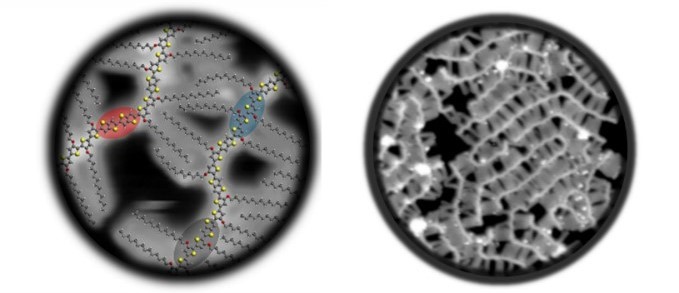Research reveals perfect foundation for organic semiconductors in solar cells and smartwatches
New research from the materials chemistry research group at imo-imomec (UHasselt/imec/EnergyVille) offers, for the first time, insights into how defects occur in conjugated polymers. Polymers are sustainable materials with many potential applications, including use in flexible solar cells, sensors, and smartwatches. "But because defects easily occur, they are not yet optimally utilized. Through our research, we are now creating a step-by-step plan to achieve the perfect foundation for polymer semiconductors," say Prof. Dr. Wouter Maes and Dr. Jochen Vanderspikken.


header photo: prof. dr. Wouter Maes & dr. Jochen Vanderspikken
Conjugated polymers are (semi)conductive materials composed of long chains of the same building blocks. Put simply, you can compare the best-performing conjugated polymers to a chain of red and blue balls linked together to form a long chain through which signals are transmitted. This allows polymers to be used as conductors in applications such as solar cells, sensors, or smartwatches. Because they consist of basic elements like carbon, oxygen, and hydrogen, they are much more sustainable than the inorganic semiconductors made from much rarer resources that are currently used.
"For years, it was assumed that when you combine the red and blue balls to make conjugated polymers, they would nicely alternate in the chain, with a blue building block consistently attaching to a red one," says researcher Dr. Jochen Vanderspikken from EnergyVille/UHasselt. "Our research, in collaboration with imec, KU Leuven, VUB, UMons, University of Birmingham, and Stanford University, now shows for the first time that this is not always the case. Within polymers, it is often the case that building blocks of the same color attach to each other, causing the polymers to work less effectively."

photo: polymers in which building blocks of the same color link together
Defects visualized
This is the first time that these defects are effectively visualized and assigned a numerical value. The researchers achieved this by using a molecular scanning tunneling microscope that provided unprecedented insights into the structure of polymeric organic semiconductors. To do this, Jochen Vanderspikken spent seven months at the prestigious American university, Stanford, with the support of FWO and Rotary Genk-Staelen.
"With this research, we can demonstrate the importance of looking at the pure chemical structure of conjugated polymers, something that has been ignored by the field for too long. We now show that these defects exist and play a role in how efficiently the polymers work. This is a significant step towards broader utilization of conjugated polymers," says Prof. Dr. Wouter Maes.

photo: defects in polymers (shaded in red and blue) have been visualized for the first time
Perfect foundation
In addition to protocols for detecting defects, the researchers also worked on a step-by-step plan to avoid these defects in the future. "In simple terms, we found that if you split a blue building block in two and place it on the outer sides of a red molecule, you will always have a nice chain of alternating red and blue building blocks as the basis for your polymer," says Dr. Jochen Vanderspikken. "With this step-by-step plan, researchers can now worldwide work on creating conjugated polymers that are identical to each other because reproducibility was difficult due to the defects that appeared. Finally, the foundation of the material is now solid."

photo: the researchers' step-by-step plan for the perfect foundation for polymers
Solar cells and sensors
The researchers aim to use this perfect foundation for conjugated polymers to scale up the materials and use them in broader applications, such as flexible solar cells, detectors, and sensors for various medical applications.
This research was published in Advanced Functional Materials. You can read the full study here.
More info
dr. Jochen Vanderspikken: 0478 33 23 61
